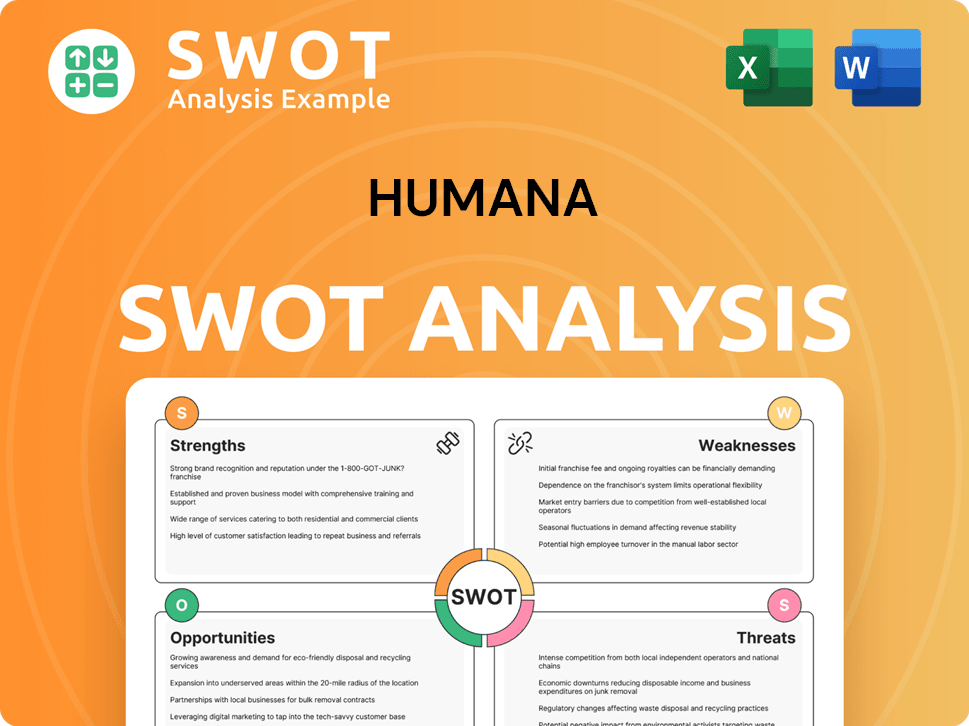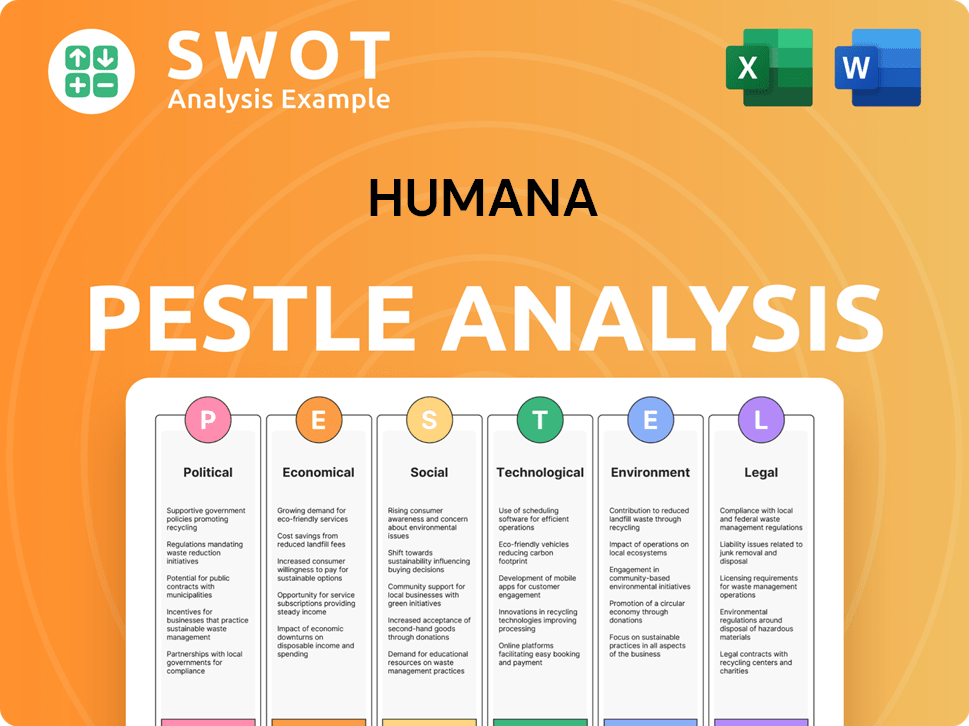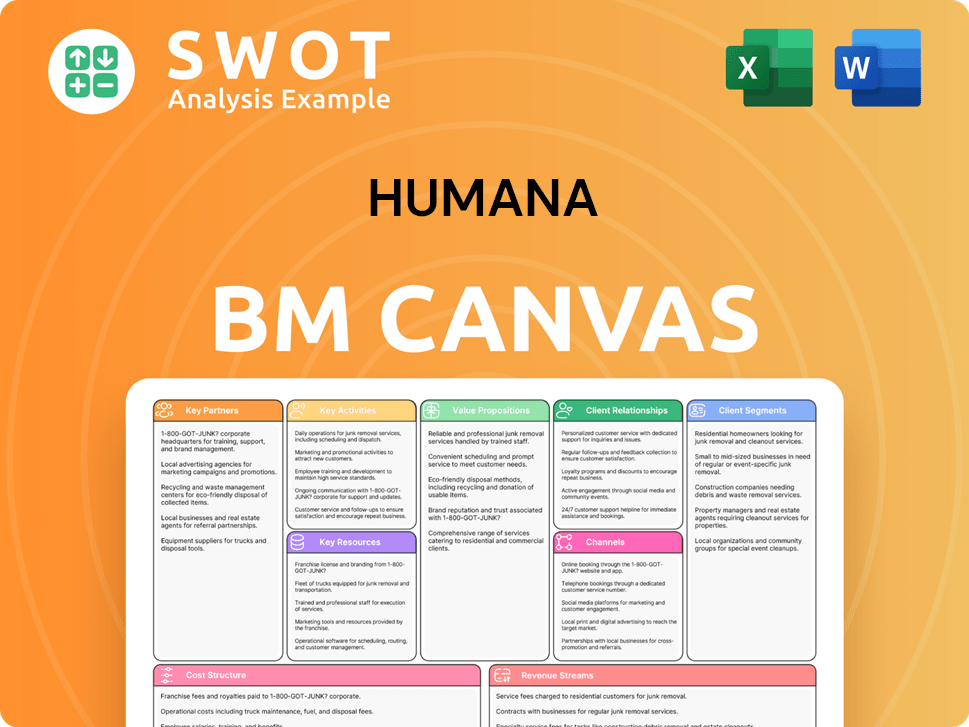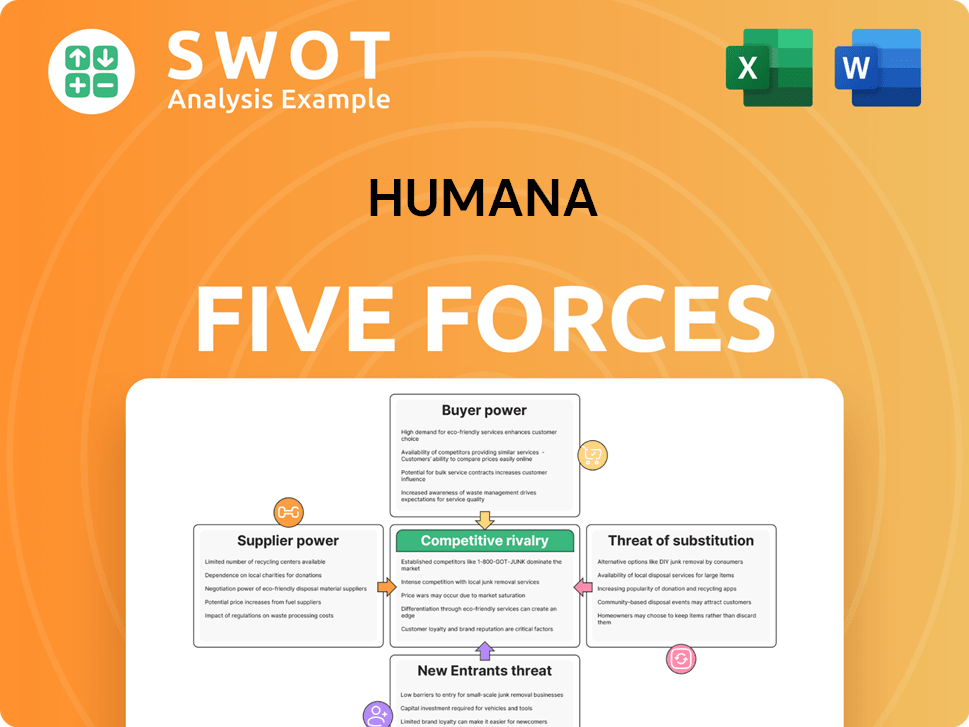Humana Bundle
Can Humana Maintain Its Momentum in the Evolving Healthcare Landscape?
Humana's recent reaffirmation of its 2025 financial guidance highlights its confidence amidst a dynamic healthcare environment. From its origins as a nursing home operator, Humana has dramatically transformed, now ranking as a leading health insurance provider. This Humana SWOT Analysis can provide a deeper understanding of the company's strategic position.

This comprehensive analysis delves into Humana's growth strategy, exploring its expansion plans, innovative initiatives, and strategic financial planning. We'll examine Humana's future prospects within the health insurance market, considering healthcare industry trends, competitive pressures, and potential challenges. Understanding Humana's company analysis is crucial for investors and stakeholders alike, as the company navigates ongoing changes and strives for sustained financial performance.
How Is Humana Expanding Its Reach?
Humana's expansion initiatives in 2024 and 2025 showcase a strategic shift towards optimizing its portfolio for long-term value creation, especially within its government-backed healthcare programs. This Humana company analysis reveals a focus on sustainable growth and profitability.
The company is actively refining its presence in the Medicare Advantage (MA) market, while simultaneously pursuing growth in other key areas such as Medicaid and primary care services. These initiatives underscore Humana's commitment to diversifying revenue streams and strengthening its integrated care delivery model, adapting to evolving healthcare industry trends.
This approach reflects a proactive strategy to navigate the health insurance market and capitalize on emerging opportunities, ultimately influencing Humana's financial performance and long-term outlook.
Humana is strategically adjusting its Medicare Advantage (MA) plans. The company anticipates an individual MA annual membership decline of roughly 550,000 in 2025. This is a result of exiting certain unprofitable plans and counties, a move designed to improve margins.
Humana is actively growing its Medicaid business. The company expects its Medicaid membership to increase by between 175,000 and 200,000 members in 2025. This expansion is supported by recent contract wins, such as the intent to be awarded a contract in Illinois.
Humana is significantly expanding its CenterWell primary care footprint. By the end of 2024, Humana operated over 340 primary care centers through its CenterWell Senior Primary Care and Conviva Senior Primary Care brands. The company plans to open approximately 100 new payer-agnostic clinics operated by its CenterWell subsidiary between 2023 and 2025.
Humana is leveraging strategic partnerships to fuel its expansion. A joint venture with Welsh, Carson, Anderson & Stowe provides up to $1.2 billion in additional capital to support the opening of new clinics. CenterWell Pharmacy was also selected as the fulfillment pharmacy for NovoCare® Pharmacy's weight loss medication, expanding its reach in specialty pharmacy services.
Humana's expansion strategy focuses on strategic adjustments in Medicare Advantage, significant growth in Medicaid, and the aggressive expansion of its CenterWell primary care clinics. These initiatives are designed to position Humana for long-term growth and profitability.
- Focus on profitable MA plans
- Growth in Medicaid, particularly D-SNPs
- Expansion of CenterWell primary care clinics
- Strategic partnerships for capital and service expansion
Humana SWOT Analysis
- Complete SWOT Breakdown
- Fully Customizable
- Editable in Excel & Word
- Professional Formatting
- Investor-Ready Format

How Does Humana Invest in Innovation?
The company leverages technology and innovation to drive sustained growth, focusing on enhanced care delivery, digital transformation, and strategic partnerships. A key aspect of its strategy involves significant investments in its CenterWell segment, which includes pharmacy, primary care, and home solutions. These investments are critical for improving health outcomes and enhancing the member experience through integrated care.
In 2024, the company focused on creating tailored care plans for each member and significantly invested in preventive health measures. This approach aligns with broader healthcare industry trends, emphasizing proactive health management. The company's strategic initiatives for growth are centered around improving member satisfaction and operational efficiency.
The company's approach to digital transformation is evident in its efforts to streamline operations and improve efficiency. While specific details on R&D investments in cutting-edge technologies like AI or IoT for 2024-2025 are not extensively detailed, the company's overall strategy emphasizes operational excellence and effective medical cost management, which often rely on technological advancements.
The company is streamlining operations and improving efficiency through digital initiatives. This includes leveraging data analytics and digital tools to manage medical utilization trends and enhance the benefit ratio. The company's investment in telehealth services is also a part of this transformation.
Strategic partnerships play a crucial role in the company's innovation strategy. A key example is the expansion of its comprehensive kidney care program in collaboration with Monogram Health, announced in February 2025. These partnerships aim to improve patient outcomes through value-based care.
Significant investments are made in the CenterWell segment, which includes pharmacy, primary care, and home solutions. These investments are critical for improving health outcomes and enhancing the member experience through integrated care. This is a key driver of the company's long-term financial outlook.
The company is focused on improving its Star Ratings performance, which often involves technological enhancements to care coordination and member engagement. This focus reflects the company's commitment to leveraging innovation for growth and improving customer satisfaction ratings.
The company is investing in preventive health measures to create tailored care plans for each member. This approach is part of the company's strategy to adapt to healthcare changes and improve its impact on the aging population. These measures are designed to enhance member health outcomes.
The company continuously refines its care models and expands its CenterWell services, demonstrating a commitment to leveraging innovation for growth. This includes efforts to improve care coordination and member engagement, which are key components of their innovation in healthcare delivery.
The company's approach to innovation and technology is multifaceted, focusing on digital transformation, strategic partnerships, and investments in key segments like CenterWell. These initiatives are designed to enhance care delivery, improve operational efficiency, and ultimately drive sustainable growth. For a deeper dive into the company's financial structure, consider reading about the Revenue Streams & Business Model of Humana.
- Digital Transformation: Streamlining operations through data analytics and digital tools to manage medical utilization and improve the benefit ratio.
- Strategic Partnerships: Expanding care programs, such as the kidney care program with Monogram Health, to improve patient outcomes.
- CenterWell Investments: Focusing on pharmacy, primary care, and home solutions to enhance member experience and health outcomes.
- Preventive Health: Creating tailored care plans and investing in preventive health measures to improve the health of its members.
- Star Ratings: Enhancing care coordination and member engagement through technological advancements to improve Star Ratings performance.
Humana PESTLE Analysis
- Covers All 6 PESTLE Categories
- No Research Needed – Save Hours of Work
- Built by Experts, Trusted by Consultants
- Instant Download, Ready to Use
- 100% Editable, Fully Customizable

What Is Humana’s Growth Forecast?
The financial outlook for Humana in 2025 centers on regaining 'compelling, normalized margins' after a difficult 2024. The company is strategically navigating the health insurance market and focusing on long-term value. This approach is crucial amidst evolving healthcare industry trends and competitive pressures.
Humana's 2024 results showed a net loss of $693 million in Q4, impacting overall profitability. Despite this, revenues for the full year 2024 increased to $117.8 billion. The company's strategic initiatives are designed to address these challenges and capitalize on opportunities within the healthcare sector.
Looking ahead, Humana's focus remains on sustainable growth and adapting to healthcare changes. The company is also advancing its Medicaid and CenterWell strategies, which are expected to contribute increasingly to earnings over the mid and longer term. For a deeper dive into the company's structure, you can explore the details at Owners & Shareholders of Humana.
Humana's full-year 2024 revenues reached $117.8 billion, up from $106.4 billion in 2023. However, net profit decreased to $1.2 billion, a significant drop from $2.5 billion in 2023. The fourth quarter of 2024 saw a net loss of $693 million.
Humana has affirmed its adjusted full-year EPS guidance of approximately $16.25 for 2025, consistent with the $16.21 adjusted EPS in 2024. GAAP EPS guidance for 2025 is approximately $14.68. Q1 2025 results showed a GAAP EPS of $10.30 and an adjusted EPS of $11.58, exceeding expectations.
The Insurance segment's adjusted benefit ratio for Q4 2024 was 91.9 percent and 87.4 percent in Q1 2025. The expected full-year 2025 Insurance segment benefit ratio is guided to be between 90.1 percent and 90.5 percent. These figures are crucial for understanding Humana's financial health.
Humana's debt-to-total capitalization increased to 42.8 percent at March 31, 2025, influenced by a $1.5 billion issuance of senior notes in March 2025. The net profit margin for the quarter ending March 31, 2025, was 1.42%. The gross profit for the twelve months ending March 31, 2025, was $18.187 billion.
Humana is navigating the health insurance market by focusing on sustainable, long-term value. The company is adapting to healthcare changes and investing in telehealth services.
- Expected individual Medicare Advantage membership decline of approximately 550,000 in 2025.
- Advancing Medicaid and CenterWell strategies for future earnings.
- Focus on returning operating margins to more normal levels within the five-year forecast period.
- Emphasis on pricing strategy to maintain long-term value.
Humana Business Model Canvas
- Complete 9-Block Business Model Canvas
- Effortlessly Communicate Your Business Strategy
- Investor-Ready BMC Format
- 100% Editable and Customizable
- Clear and Structured Layout

What Risks Could Slow Humana’s Growth?
The path of Humana's growth strategy and future prospects faces several significant risks and challenges. These primarily relate to the evolving landscape of Medicare Advantage (MA) and the increasing regulatory scrutiny within the healthcare industry. Understanding these obstacles is crucial for any Humana company analysis and assessing its long-term financial outlook.
One of the most pressing issues is the decline in Humana's Medicare Advantage Star Ratings for 2025. This downturn could severely impact the company's revenue, operating results, and cash flows. Moreover, the health insurance market is highly competitive, with rivals intensifying their focus on the MA market, which could threaten Humana's market share analysis.
Furthermore, the healthcare industry trends, including regulatory changes and shifts in healthcare policy, present ongoing threats. Adapting to these changes and mitigating their impact is critical for Humana's survival and success. For a deeper understanding, consider reading a Brief History of Humana.
A significant risk stems from the decline in Humana's Medicare Advantage Star Ratings for 2025. Only 25% of its MA enrollees are in plans rated 4 stars or higher for 2025, a sharp decrease from 94% in 2024. This could negatively affect the company's 2026 quality bonus payments from CMS.
Increased competition in the health insurance market, particularly in the Medicare Advantage sector, poses a threat. As competitors ramp up their focus on this market, Humana's top-tier position could face challenges. This intensifies the need for strategic initiatives for growth to maintain a competitive edge.
Higher-than-anticipated medical utilization trends in late 2023 and into 2024 led to mispricing of plans and margin pressures. While Humana projects a deceleration in cost trends to mid-single digits for 2025, industry peers anticipate elevated trends, creating uncertainty for achieving targeted MA operating margins by 2027.
Regulatory changes, such as the CMS Final RADV Rule, could influence profitability. Healthcare policy changes during future election cycles also present risks. 'Medicare for All' scenarios, though viewed as a low-single-digit risk, could impact most of the company's operations.
Operational risks include the need to exit unprofitable MA plans and counties. The company's focus on retaining members in segments expected to drive sustainable, long-term value is critical. These strategic shifts are vital for navigating the challenges and adapting to healthcare changes.
Humana's financial performance is directly impacted by these risks. The company's ability to achieve its targeted MA operating margins by 2027 is uncertain due to elevated cost trends. These factors influence Humana's revenue growth drivers and overall long-term financial outlook.
To mitigate these risks, Humana is prioritizing margin improvement, exiting unprofitable MA plans and counties, and focusing on retaining valuable members. The company is also diversifying its growth by expanding its Medicaid and CenterWell primary care businesses. These strategies are essential for navigating the challenges and ensuring Humana's long-term financial outlook.
Humana's management is actively assessing and preparing for these risks through strategic shifts. The company is investing in operational excellence and improving its Star Ratings performance. These strategic initiatives for growth are crucial for adapting to healthcare changes and maintaining a competitive edge in the market.
Humana Porter's Five Forces Analysis
- Covers All 5 Competitive Forces in Detail
- Structured for Consultants, Students, and Founders
- 100% Editable in Microsoft Word & Excel
- Instant Digital Download – Use Immediately
- Compatible with Mac & PC – Fully Unlocked

Related Blogs
- What are Mission Vision & Core Values of Humana Company?
- What is Competitive Landscape of Humana Company?
- How Does Humana Company Work?
- What is Sales and Marketing Strategy of Humana Company?
- What is Brief History of Humana Company?
- Who Owns Humana Company?
- What is Customer Demographics and Target Market of Humana Company?
Disclaimer
All information, articles, and product details provided on this website are for general informational and educational purposes only. We do not claim any ownership over, nor do we intend to infringe upon, any trademarks, copyrights, logos, brand names, or other intellectual property mentioned or depicted on this site. Such intellectual property remains the property of its respective owners, and any references here are made solely for identification or informational purposes, without implying any affiliation, endorsement, or partnership.
We make no representations or warranties, express or implied, regarding the accuracy, completeness, or suitability of any content or products presented. Nothing on this website should be construed as legal, tax, investment, financial, medical, or other professional advice. In addition, no part of this site—including articles or product references—constitutes a solicitation, recommendation, endorsement, advertisement, or offer to buy or sell any securities, franchises, or other financial instruments, particularly in jurisdictions where such activity would be unlawful.
All content is of a general nature and may not address the specific circumstances of any individual or entity. It is not a substitute for professional advice or services. Any actions you take based on the information provided here are strictly at your own risk. You accept full responsibility for any decisions or outcomes arising from your use of this website and agree to release us from any liability in connection with your use of, or reliance upon, the content or products found herein.